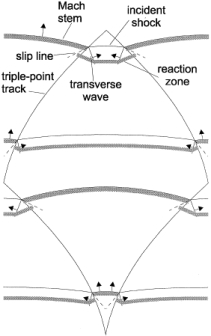
|
BRHS /
Detonation front structureStandard practice of evaluation possible hazards, which can come from detonation precesses is usually based on the theory of steady state one-dimensional detonation. The predictions of such theory are well-known and usually can have sufficient accuracy to provide necessary information for industrial designs.  Figure 1. Schematic presentation of multi-dimensional detonation front structure (KuoKK:2005). However there are numerous examples demonstrating non-stationary and multi-dimensional nature structure of the detonations. These features can affect the maximum local pressures during detonation process and therefore can be important from the point of view of safety aspects for industrial applications. Detonation waves in the mixtures, which are far enough from detonation limits, have internal multi-dimensional structures. Already classical works on structure of detonation waves, e.g. ((VoitsekhovskiiBV:1966), (StrehlowRA:1970), (StrehlowRA:1969b), (StrehlowRA:1969c)), permitted to discover different type of detonation waves:
In case of lean or reach mixtures, which are close to their detonation limits, detonations occur usually exhibiting characteristics of the second or third types. Unfortunately, most of the experimental work was performed for the mixtures far from detonation limits, and detonations of marginal mixtures are not studied in full volume. Note that the role of front structure, as a rule, appears to be more significant in case of lean mixtures detonations, which are typical for industrial accidents. Multi-dimensional structure of the detonation front includes leading shock wave and a number of transverse waves, which propagates perpendicular to the leading shock, reflecting from each other and from bounding walls. The surface of the leading shock consists of the sequence of convex parts, which start chemical reaction, and concave parts which are fast decaying waves. Additional reaction zones are located behind the transverse waves where the reaction completes. {bibtexcitelist:AS} << Detonation limits | Content | Detonation cell size >> |